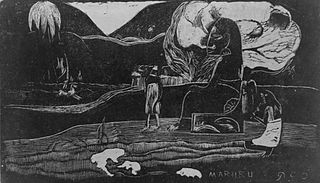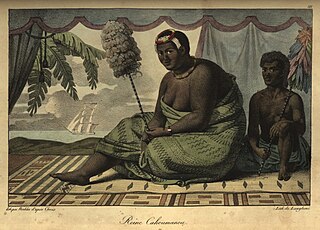Related Research Articles

The Polynesian narrative or Polynesian mythology encompasses the oral traditions of the people of Polynesia together with those of the scattered cultures known as the Polynesian outliers. Polynesians speak languages that descend from a language reconstructed as Proto-Polynesian - probably spoken in the Tonga - Samoa area around 1000 BC.
Māui (Maui) is the great culture hero and trickster in Polynesian mythology. Very rarely was Māui actually worshipped, being less of a deity and more of a folk hero. His origins vary from culture to culture, but many of his main exploits remain relatively similar.

Hina is the name assigned to a number of Polynesian deities. The name Hina usually relates to a powerful female force who has dominion over a specific entity. Some variations of the name Hina include Sina, Hanaiakamalama, and Ina. Even within a single culture, Hina could refer to multiple goddesses and the distinction between the different identities are not always clear. In Hawaiian mythology, the name is usually paired with words which explain or identify the goddess and her power such as Hina-puku-iʻa (Hina-gathering-seafood) the goddess of fishermen, and Hina-ʻopu-hala-koʻa who gave birth to all reef life.
In Hawaiian mythology, Kaulu is a trickster god who killed goddess Haumea at Niuhelewai, by catching her in a net obtained from Makali’i. He then killed Lonokaeho, also called Piokeanuenue, king of Ko'olau, by singing an incantation. Kaulu is known for being extremely powerful and strong, both physically and with magic, and he had many adventures in Hawaiian mythology.
Tangaroa is the great atua of the sea, lakes, rivers, and creatures that live within them, especially fish, in Māori mythology. As Tangaroa-whakamau-tai he exercises control over the tides. He is sometimes depicted as a whale.

In Hawaiian mythology, Laka is the name of two different popular heroes from Polynesian mythology.. Lengthy legends of their exploits extend throughout the islands, and the kings of Tahiti and Hawaiʻi claimed them as their ancestors.

Kaʻahumanu was queen consort and acted as regent of the Kingdom of Hawaiʻi as Kuhina Nui. She was the favorite wife of King Kamehameha I and also the most politically powerful, and continued to wield considerable power as co-ruler in the kingdom during reigns of his first two successors.

Kaumualiʻi was the last independent aliʻi nui of Kauaʻi and Niʻihau before becoming a vassal of Kamehameha I within the unified Kingdom of Hawaiʻi in 1810. He was the 23rd high chief of Kauaʻi and reigned during 1794–1810.
Hemā is a figure in both Hawaiian and Maori mythology.
In the mythology of the Tuamotu archipelago, Kiho-tumu represents the supreme god.
In the Polynesian narrative of the Tuamotus archipelago in the South Pacific, Puna is the king of Hiti-marama or of Vavaʻu, depending on the story.
In Tuamotu mythology, Vahieroa marries Matamata-taua or Tahiti-to'erau, and on the night of the birth of their son, the great Tuamotuan hero, Rata, the parents go fishing and are snatched away by the demon bird belonging to Puna, king of Hiti-marama, "an island north of Pitcairn and Elizabeth but long since swallowed in the sea."

Princess Kalani Ahumanu i Kaliko o Iwi Kauhipua o Kīnaʻu, also known as Elizabeth Kīnaʻu was Kuhina Nui of the Kingdom of Hawaiʻi as Kaʻahumanu II, Queen regent and Dowager Queen.
Rata, in Tahitian mythology, is said to have become king of Tahiti when his uncle, king Tumu-nui, and his father Vahieroa are swallowed by a great clam while they are on their way to Pitcairn. When he reaches adulthood, Rata plans to avenge his father. As in the Tuamotuan version, Rata identifies a tree to build his canoe, but it is protected by forest elves. After he captures them they build it for him in a single night. While en route for Pitcairn, Rata and his crew are sucked down into the same clam, but they use their spears to cut the monster open. They rescue the remains of Rata's father and uncle and bury them back in Tahiti. After recovering from their adventure, Rata sets out for further adventures. See also Aremata-Popoa and Aremata-Rorua.

In Hawaiian religion, Māui is a culture hero and ancient chief who appears in several different genealogies. In the Kumulipo, he is the son of ʻAkalana and his wife Hina-a-ke-ahi (Hina). This couple has four sons, Māui-mua, Māui-waena, Māui-kiʻikiʻi, and Māui-a-kalana. Māui-a-kalana's wife is named Hinakealohaila, and his son is named Nanamaoa. Māui is one of the Kupua. His name is the same as that of the Hawaiian island Maui, although native tradition holds that it is not named for him directly, but instead named after the son of Hawaii's discoverer.
In Tuamotu mythology, Vahi-vero is the son of the demigod Kui and a goblin woman named Rima-roa.
Faumea is a figure in Polynesian mythology, specifically that of the Tuamotus archipelago of French Polynesia, where she is regarded as an "eel-woman". The sea god Tangaroa encounters her when he sails to her island. In addition to being an eel-woman, Faumea has eels within her vagina which eat men, reflecting the folk concept of vagina dentata. However, Faumea teaches Tangaroa how to lure the eels out and they have sex. Faumea bears Tangaroa two sons: Tu-Nui-Ka-Rere and Turi-A-Faumea.
Marie Mariterangi, Marie Mariteragi, Marie Terangi or Marie was a singer, songwriter of Polynesian pop music, guitarist and ukulele player. She was born on May 3, 1926 in Hikueru in French Polynesia and died on April 27, 1971 in Papeete in French Polynesia.
Rogo-Tumu-Here was an octopus demon from Tuamotu mythology. He attacked and swallowed Hina-Arau-Riki, the wife of Turi-A-Faumea, son of Tangaroa and Faumea, and was slain by the former males along with Tu-Nui-Ka-Rere.
References
- M. Beckwith, Hawaiian Mythology (University of Hawaii Press: Honolulu) 1970.